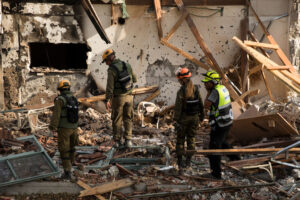The news that mobile networks had gone down in the strip was the clue that something was imminent. Then, last night, just under three weeks after the 7 October Hamas massacres, Israel announced that its ground forces were “expanding operations” in Gaza. Aerial bombardment of the strip was heavier than anything since the war began; more ground troops are pouring across the border.
It all came as a surprise. The government’s war cabinet is not even scheduled to meet until Sunday (which could, of course, be a deliberate misdirection). And I’m told soldiers on the Northern border are receiving weekend leave (subject to immediate recall), which would not normally suggest that a full-on invasion is happening.
One former IDF official I did speak to last night was unsure that this was the all-out invasion. Hamas reportedly offered 100 hostages for four-day ceasefire. Israel countered by offering two days for all hostages. “Then the talks collapsed,” they said. “So this can be one way to put pressure on them.”
The hostages have complicated everything. Hamas has 229 of them — something Israel has never had to deal with before. When Hamas kidnapped IDF soldier Gilad Shalit in 2006, Jerusalem traded over 1,000 Palestinian prisoners for his return. While Hamas holds these civilians, it has unimaginable leverage. Walking around Israeli cities, you see posters of hostages everywhere: on walls, lampposts, stuck to trees and flying from cars. Joe Biden and Benjamin Netanyahu met recently, and the hostages were at the centre of their discussions.
Central to this part of the war are the Qataris. Leant on by the United States, Doha managed to negotiate the release of Hamas’s four hostages earlier this week. “Qatar are the funders and hosts of Hamas leadership,” the former official explains. “When the Qataris call, the fucking pieces of shit Hamas answer the phone. They do not do things that piss off Doha.”
And so, on Friday night, a picture was emerging of the start of a gradual widening of operations. According to Peter Lerner from the IDF spokesperson’s unit, over the past few days IDF ground forces have carried out a number of targeted raids inside the Gaza Strip to prepare for future stages. “In the last few hours,” he told me, “the IDF has expanded strikes and struck underground targets and terrorist infrastructure…ground forces are expanding their ground activities this evening.”
The “delay” in starting, then, is not the result of hesitation but, rather, a systematic process the military has gone through. This began with an assessment of the 7 October massacres. From the IDF’s point of view these resulted from three failures. The first was intelligence: the security services and military were convinced that all the information coming out of Gaza indicated that Hamas did not want a confrontation with Israel.
The second was what might loosely be called the “physical failure”. For years, the threat to Israel was deemed to be from tunnels snaking under the border; for over a decade, Hamas and affiliates had spent around $30 to $90 million on that labyrinth. In response, Israel constructed a barrier that reportedly reaches 100 metres depth in places, dotted with underground sensors. So their defence focus was almost entirely subterranean. But all the tonnes of cement and technology amounted to nothing. Terrorists went over the top, cutting through the barbed wire border fence with $20 bolt cutters. And when they didn’t directly attack the fence, they flew over it on paragliders or circumnavigated it by water. It was, an Israeli diplomat told me, “Biblically simple”.
The third failing was the lack of requisite forces to respond. With enough troops, regardless of the other shortcomings, the atrocity might have been prevented. But, in some cases, it was ten hours or longer before soldiers arrived, which gave a thousand terrorists more than enough time to murder, rape and burn.
“It was obviously planned and executed very well,” said Lerner. “In a way that challenged Israel’s conception of the arena.” This is instructive. The attack took place on the 50th anniversary of the Yom Kippur war. And back then, Israeli laxity was much to blame. The security establishment in 1973 thought the Arab states would not try another attack after their decisive defeat in the Six-Day War seven years previously. Security experts were convinced that the Egyptian troop movements were merely exercises. Back then, they were overconfident. It seems the same was true on this Holy Day.
On Friday I visited a Tel Aviv institution — Halper’s English Bookstore. When not interrupted by air raid sirens and loud booms thundering through the skies, the owner Yossi Halper made his thoughts clear: “For a month, the TV here ran endless programs on the Yom Kippur War. Saying how we were caught with our pants down, and how that would never happen again. And it did.” He pauses. “In fact, literally: some of the soldiers killed were in their underpants, as they’d been sleeping.”
Much has been made of past year’s political divisions, stemming from the government’s proposed judicial reforms, which are blamed for being the distraction that resulted in the inadequate response. But officials reject this, assuring me that the intelligence community sits beyond politics. The necessary post-mortem, when it eventually comes, will have to take many things into account, not least what signs were missed and why. Back in 1973, the resulting inquest brought down Defence Minister Moshe Dayan and led to the emergence of the Likud as Israel’s dominant political party. By any normal laws of politics, Netanyahu should be finished. But these are not normal times.
Recriminations are for tomorrow, though. Since 7 October, IDF and security services have focused on three core efforts. The first was restoring security to the south. The IDF caught a terrorist just last week, on day 14 in the southern sector. The situation there remains, if not active then vigilant, as far as the military is concerned. While most of the terrorists were killed, there is the possibility that a few remain, hidden in the fields around the border areas. So protection is the most important thing, with sufficient forces stationed there, unlike before. The second priority was rebuilding the border defences. The thought of another attack in the south is militarily, politically and above all psychologically impermissible. If Hamas broke through again, it would be too much for the people here to bear. The IDF is conducting small-scale cross border raids along the immediate perimeter of the barrier, looking for more bodies (10 people remain unaccounted for) and any Hamas targets they can find. On Thursday night Israeli forces carried out another raid.
Finally, there is what happened last night. The “escalation of the military operation”, or more simply, “taking the war to them”. The goal is clear, and stark. “Dismantle, destroy, hunt down the leaders, the organisations and the individuals who participated in the massacres. Tearing the whole system apart and changing the paradigm.”
This is beyond anything Israel has previously considered: to ensure that Hamas no longer exists as a governing force able to use Gaza as a staging post for attacks against Israel. What this means in practice is open to debate. It is clearly impossible for Israel to wipe out every Hamas operative in Gaza: they do not wear military uniforms and do not have bases or headquarters beyond the civilian buildings they operate from. While Israel has zero intention — or so I am told — of taking control of Gaza, it should not be forgotten that it was bogged down in Lebanon for 20 years after a supposedly quick operation to take out militants there; and of course, the lessons of Iraq and Afghanistan are now universal.
The war cabinet thrown together in the wake of 7 October includes Netanyahu’s former political rival Benny Gantz, who also IDF Chief of Staff from 2011 to 2015. He has insisted on a clear plan on how Israeli forces will leave Gaza after defeating Hamas there and what type of governmental structures should be left in place. By all accounts this plan is still being put together. But, as we saw last night, things tend to move quickly in this part of the world.
Estimating that it will face around 30-40,000 Hamas terrorists, Jerusalem is mobilising over 300,000 reservists, the largest in its history — more than the Kremlin sent to invade Ukraine in February last year. There are two components to this mobilisation. First, the government must green-light it. There has, as of writing, been nothing official on this yet. Second, the optimal operational conditions must be reached: this means they need to take down the Hamas lookout posts, command and control structures, and the booby traps. “We will not jeopardise our forces for the sake of rapid mobilisation,” I was told.
Israel is a country that has always revered its soldiers. Reckless deployment and unecessary sacrifice is unconscionable in a small country that relies on every citizen taking up arms if necessary. As a result, this second component does not yet appear to have been fully completed. It is also complicated by the fact that so many hostages are still hidden. But thousands of soldiers are now fighting in Gaza. The first wave of the invasion has undoubtably begun. The defence establishment seems a step closer towards honouring its promise to take out Hamas and the war is about to get even bloodier than ever.
Disclaimer
Some of the posts we share are controversial and we do not necessarily agree with them in the whole extend. Sometimes we agree with the content or part of it but we do not agree with the narration or language. Nevertheless we find them somehow interesting, valuable and/or informative or we share them, because we strongly believe in freedom of speech, free press and journalism. We strongly encourage you to have a critical approach to all the content, do your own research and analysis to build your own opinion.
We would be glad to have your feedback.
Source: UnHerd Read the original article here: https://unherd.com/




